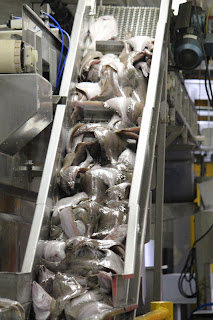I was in Kodiak all last week for a fisheries conference. It was a great place for a fisheries
conference since it’s definitely a town where there are two primary types of
employment – fisheries (fishing, processing) and the Coast Guard. I was fortunate enough to get to see both up
close. I’ll post about the fish
processing tour and the Coast Guard hangar tour separately (keep reading, they
should be below). I’ll also post a lot
more of my photos from the week on my flickr site (http://www.flickr.com/photos/steadyrain/).
First, some details on Kodiak, in case you’re curious. It’s stunningly beautiful (I’m starting to
sound like a broken record though, seems like everywhere in this state could be
called the same!). The city of Kodiak is
small by lower-48 standards but big for AK, with about 6000 people. It’s about a 1 hour flight from Anchorage,
either by Era Airlines or Alaska Airlines.
I was on Era for the flight there, it was a twin prop DASH-8 that seats
about 40 or so. The Alaska Airlines
flights use a larger plane, often with half the cabin divided off for cargo and
the back half with seats for passengers.
I’ve heard lots of tales of very rough flights, sounds like the winds
can get pretty high and toss the planes around.
In a lot of the smaller airports around
AK the planes taxi down the runway to the end and then whip a shitty and take
off (pretty sure the pilots have another name for the manoeuver, but I call a
spade a spade). I managed to take this
picture as we turned for the take off.
You’d hate the botch the take-off on a runway like this, not a lot of
room for error.
One of the tour options was a visit to the windmills on
Pillar Mountain. I didn’t go on that
tour, but I heard from those who did some interesting tidbits. The city is currently largely powered by diesel,
which is expensive and obviously has to be shipped in. The windmills are relatively new and becoming
very popular with the locals. I don’t
remember how much power is currently generated with them (20% is sticking in my
head), but the city (maybe even the whole island?) hopes to be 98-99% wind
powered by 2020. That’s pretty neat-o.
Much like Juneau, there’s not a lot of roads on Kodiak. Most of the ‘Kodiak’ grizzly bear viewing is
far from the city of Kodiak and reached by boat or small plane. Halibut fishing is also a huge attraction, as
it should be since they’re so yummy. I
would absolutely love to live in Kodiak…I liked the vibe of the city and I’d
fish every day I could and watch the storms roll in when I couldn’t.






























